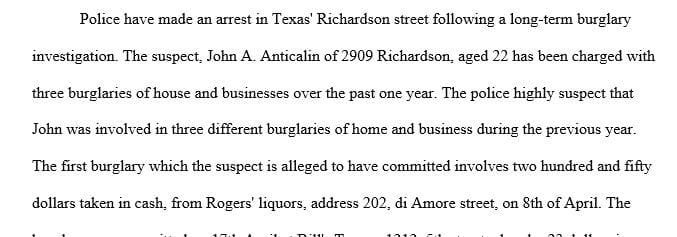Write a news story from this audio recording of a news conference about an arrest by local police.
Requirement
Your assignment is to write a news story from this audio recording of a news conference about an arrest by local police. Remember to text questions to the spokesperson.
Crime News Conference_1.m4a
I just need you to take this considerations in mind from the class about crime news stories
Covering crime, accidents & courtrooms lecture notes
YOUR PREPARATION— do some background research, if at all possible, even on breaking stories.
Preparing for the crime story — initial reporting often at the scene; most information comes from police, victim(s) and witness(es); think convergence (audio/video, digital camera); timing is important; always check the police report, but do your own reporting; check news library upon return from crime scene.
Preparing for accident and fire stories — check the official report first; if you’re on the scene, you’ll need to get basic information (what hap- pened, where, victim information, injuries, witnesses).
Preparing for the court story — most stories are follow-ups; often diffi- cult and complex, so ask attorneys and judges lots of questions before and/or after court sessions and during recesses.
WRITING THE STORY
The crime story — chronological order vs. inverted pyramid; possible “so what” sidebars.
Accident and fire stories — observe and actively solicit information; keep digital recorder and camera handy, and collect basic information; question person in charge; try to find and interview witnesses; try to find friends or relatives of the victims; interview the victims if possible; talk with others at the scene; be sensitive to victims and their families; sketch elements of the scene on paper; record your interviews.
Several tips for police stories:
Names, ages, addresses, condition of victims.
Witness accounts and/or police re-creation.
When and where accident occurred.
Why or how it happened, or who was at fault (as determined by officials).
Fires are more difficult and dangerous because they’re active, more confusing; fire tips:
Location.
Names, ages, addresses of those killed, injured, missing.
Name of building owner or landowner.
Value of building and contents, or land value.
Whether building and contents were insured.
When fire started, who reported, level of response.
Cause of fire, if known.
The court story — news value is paramount.
Avoiding libelous statements — accuracy is critical; ask lots of ques- tions; everything in open court is fair game, but no privilege for spectator comments during a recess.
A typical first story — arrest and charges.
Follow-up story: First court appearance — reporters must know about basics of law, federal and state court organization, and procedure.
Follow-up story: Preliminary hearing — in some states, defendants are indicted by a grand jury.
Follow-up story: Arraignment— pleas and plea bargaining happen at this stage; motions for disclosure or suppression of evidence, and for a change of venue, can follow.
Follow-up story: Trial testimony — jury selection, opening state- ments, examination of witnesses (direct, cross, re-direct) including rebuttal witnesses, jury deliberation
Follow-up story: Verdict — juries can “hang”; after a conviction, some juries can recommend a sentence; sentencing usually comes at a sentencing hearing
III. OTHER ISSUES IN CRIME AND COURT REPORTING
The free-press/fair-trial controversy — the Sheppard case; O.J. Simpson case.
Gag orders and closed trials — currently, courts generally support trials being open to the public and the media (Nebraska Press Association v. Stuart, Richmond Newspapers v. Virginia).
Covering sex crimes.
Sex crime victims — concerns about victim names being made public.Sex crime offenders — generally, proceedings are open except for some youthful witnesses.
Press-bar guidelines — not legal contracts; many media groups are withdrawing because of concerns the guidelines could become mandatory.
Cameras in the courtroom— generally allowed (in 47 states and in some lower federal courts).
Coverage of minority groups — avoid gratuitous mentions of race in crime stories; also, sexual orientation should be off limits unless it is the focus of a story (Dahmer case in Milwaukee).
Coverage of terrorism— alleged terrorists being held at Guantanamo Bay, Cuba.
Issues of taste and ethics.
Reporting details of crimes.
Reporting confessions and prior convictions.
Identifying juveniles — editors must decide.
Solution preview for the order on write a news story from this audio recording of a news conference about an arrest by local police.
APA
339 words
